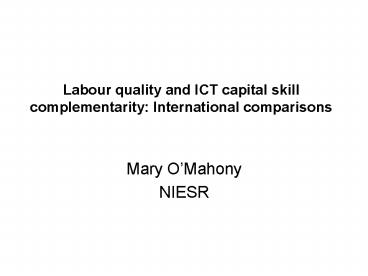Labour quality and ICT capital skill complementarity: International comparisons - PowerPoint PPT Presentation
1 / 20
Title:
Labour quality and ICT capital skill complementarity: International comparisons
Description:
Employment, value added, ICT capital and non-ICT capital and skills ... Also wage share equations for US, UK and France. Results US employment. 0.001 (0.004) ... – PowerPoint PPT presentation
Number of Views:31
Avg rating:3.0/5.0
Title: Labour quality and ICT capital skill complementarity: International comparisons
1
Labour quality and ICT capital skill
complementarity International comparisons
- Mary OMahony
- NIESR
2
Introduction
- Summary of two strands of research
- Growth accounting using data from M. OMahony
and B. van Ark eds, EU Productivity and
Competitiveness An Industry Perspective - Labour Demand (Econometric) M.OMahony,
C.Robinson and M.Vecchi The Impact of ICT on
the Demand for Skilled Labour A cross-country
comparison
3
Data Divide labour into a number of types of
skills (country specific)
4
Data
- US Current Population Survey (microdata)
- UK Labour Force Survey (microdata)
- France Labour Force Survey (INSEE tabulations)
- Germany Employment wage and salary statistics
(Statistiches Bundesamt tabulations)
5
Growth Accounting Results, Market Economy
average percentage points per annum
6
Market Economy
7
Manufacturing
8
ICT Producing Manufacturing(office machinery,
electrical electronic equipment, instruments)
9
Distribution (wholesale and retail)
10
Financial services
11
Business Services
12
Other Services
13
Capital-Skill complementarity
- Panel Regressions
- US, UK, France, Germany
- 1979-2000, sectoral datasets for each country
(30 industries) - Employment, value added, ICT capital and non-ICT
capital and skills as above (exception Germany
six categories from microzensus)
14
Specification
- Employment share equations
- Estimated separately for each country
- Estimated for the whole period, and then split
between the 1980s and 1990s
Also wage share equations for US, UK and France
15
Results US employment
Higher Associate degree Some college, no degree High School Graduation No Qualifications
Model I
k/y 0.019 (0.011) 0.002 (0.003) 0.010 (0.008) -0.040 (0.014) 0.008 (0.006)
ICTk/K 0.009 (0.003) 0.004 (0.001) 0.007 (0.002) 0.000 (0.004) -0.020 (0.003)
Model II
k/y7988 0.009 (0.013) -0.006 (0.002) 0.008 (0.008) -0.048 (0.015) 0.036 (0.013)
k/y8900 0.031 (0.010) 0.011 (0.007) 0.012 (0.013) -0.031 (0.016) -0.024 (0.009)
ICTk/K7988 0.011 (0.002) 0.004 (0.000) 0.008 (0.001) 0.008 (0.004) -0.031 (0.005)
ICTk/K8900 0.007 (0.007) 0.003 (0.002) 0.004 (0.004) -0.016 (0.013) 0.001 (0.004)
16
Results UK employment
Higher NVQ 4 NVQ 3 NVQ12 No qualifications
Model 1
k/y 0.053 (0.015) 0.013 (0.006) 0.094 (0.064) -0.111 (0.075) -0.049 (0.051)
ICTk/K 0.003 (0.003) 0.001 (0.002) 0.004 (0.006) 0.025 (0.009) -0.032 (0.016)
Model 2
k/y7988 0.023 (0.021) 0.016 (0.026) 0.147 (0.108) 0.010 (0.064) -0.196 (0.067)
k/y8900 0.064 (0.014) 0.011 (0.013) 0.070 (0.061) -0.165 (0.100) 0.020 (0.034)
ICTk/K7988 -0.007 (0.007) -0.003 (0.006) 0.005 (0.007) 0.026 (0.005) -0.020 (0.019)
ICTk/K8900 0.021 (0.006) 0.010 (0.002) -0.002 (0.011) 0.012 (0.018) -0.040 (0.019)
17
Results French employment
Higher Baccalaur eate 2yrs Baccalaur eate Voc. qualification General Education No qualification
Model 1
k/y -0.002 (0.018) 0.000 (0.017) 0.026 (0.012) -0.002 (0.022) 0.016 (0.015) -0.039 (0.039)
ICTk/K 0.025 (0.013) 0.034 (0.010) 0.018 (0.016) -0.003 (0.020) 0.002 (0.007) -0.076 (0.016)
Model 2
k/y8288 -0.039 (0.022) -0.021 (0.017) 0.044 (0.021) 0.066 (0.033) 0.073 (0.042) -0.124 (0.050)
k/y8900 0.016 (0.025) 0.010 (0.023) 0.017 (0.018) -0.034 (0.038) -0.011 (0.015) 0.002 (0.054)
ICTk/K8288 0.021 (0.012) 0.026 (0.008) 0.015 (0.006) 0.017 (0.021) 0.007 (0.012) -0.086 (0.012)
ICTk/K8900 0.028 (0.013) 0.040 (0.012) 0.020 (0.024) -0.018 (0.020) -0.002 (0.008) -0.069 (0.016)
18
Results German employment
Higher Technical degree Vocational (high) Vocational intermediate Vocational (low) No qualification
Model 1
k/y 0.003 (0.002) 0.003 (0.002) 0.003 (0.002) 0.001 (0.001) -0.005 (0.007) -0.005 (0.006)
ICTk/K 0.002 (0.002) 0.002 (0.001) 0.003 (0.002) 0.002 (0.001) 0.021 (0.005) -0.030 (0.005)
Model 2
k/y7988 0.004 (0.003) 0.002 (0.002) 0.004 (0.004) 0.001 (0.003) -0.009 (0.016) -0.003 (0.016)
k/y8998 0.002 (0.002) 0.003 (0.002) 0.003 (0.001) 0.000 (0.001) -0.003 (0.007) -0.006 (0.005)
ICTk/K7988 0.002 (0.001) 0.002 (0.001) 0.002 (0.001) 0.002 (0.001) 0.024 (0.005) -0.031 (0.004)
ICTk/K8998 0.001 (0.003) 0.002 (0.001) 0.005 (0.003) 0.002 (0.001) 0.018 (0.008) -0.028 (0.010)
19
Conclusions
- In all countries the low skilled have seen a loss
in employment share and wage share - ICT has had a positive and generally significant
impact on numbers of the highest skilled workers
Similar results found for wage share equations - Timings vary considerably between countries, with
the US showing the first and clearest signs of an
ICT impact on the demand for skilled labour
20
Conclusions
- Further work
- Controlling for age and gender, small impacts in
UK and US but do not change conclusions - Testing for structural changes
- Future Research
- Estimate industry by industry country panel
- Consider time series properties































